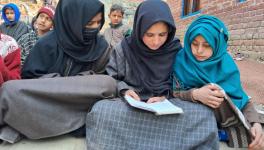Aam Aadmi Party: A Critique
The Vision Document of AAP* brings no surprises. It puts down in black and white what its main protagonists have been saying for the last two years.
It must be said to the credit of the document that it explicitly acknowledges the centrality of the Constitution of India whose preamble it quotes with approval. But it would not be correct to infer that it upholds the basics of the parliamentary democracy or democracy per se. Otherwise it would not have asserted in the very first section : “Hum satta ke kendroko dhvast karke rajnaitik satta seedhe janata ke hathme dene ja rahe hai”(After destroying the centres of authority, we are going to hand over the power directly to the people.) Surely the authors of the document are aware that the Parliament of India is the supreme centre of political authority under the Constitution. Are they oblivious of a queer mixture of anarchism and Bonapartism that characterizes this statement?
The analysis of non-fulfillment of the vision of the preamble of our Constitution is simplistic and misleading. All the evils and shortcomings are attributed to the wholesale inheritance of “colonial laws and structures” by the indigenous rulers who, according to the document, have simply substituted the erstwhile foreign exploiters. Leaving aside the patent half-truth of such a statement, what are the laws and structures that it is speaking about? It is concentrating exclusively on non-participatory and indirect features of our legislative and executive structures. It is one thing to argue in favour of more direct representative and participatory structures and entirely different to solely ascribe the “exploitative character” of the system to such features, which is what the document does.
It recommends more participatory legislative and executive structures through a more effective role to Gram Sabha, greater accountability of the executives to the people whom they are appointed to serve, introduction of “referendum” and “initiative” in the legislative process and “recall” of elected representatives. And the appointment of a Lokpal to oversee the executive and root out corruption. This is all fine. There has been good deal of debate at the popular as well as the expert level on these issues. This is not the place to enter into a debate on these specific suggestions. Suffice it to say that it is naïve to assume that the exploitative character of the economic system will simply vanish with the introduction of such administrative and legislative devices. Even more naïve is the supposition that the exploitative forces which form the bedrock of the system would not subvert the proposed more representative and participatory devices and simply allow any truly people-centric transformation of the economic system.
But the vision document is scrupulously silent on the core issue of the exploitative base of the system. It shies away from suggesting any measures intended to bring about people-centric transformation of the economic system. Such silence is the blind spot of the vision document.
The vision document misses the wood for the trees. It confuses and conflates symptoms with the disease. It talks of growing divide between the rich and the poor, of the loot of natural resources by the big business and politicians, of unemployment, of price rise, and of course, corruption. Nowhere it goes to the root of the problem which lies in the adoption of the neo-liberal policies by the entire ruling classes which include not only the ruling and the main opposition conglomerates of the political parties and the big capital, indigenous as well as foreign, but also the affluent and better-off layers of the newly emerged middle class benefiting from the neo-liberal policies, be they in IT and related sectors, financial services, advertising and marketing, print and electronic media, land and real estate, catering to conspicuous consumption of the neo-rich and their imitators, or the praetorian guard of the higher echelons of the ruling classes. Is it that a sizeable section of the followers of AAP belong to this section of our society and, therefore, the vision informing the document gets distorted and blurred?
The vision document looks around at the contemporary symptoms. It refuses to see the current situation as a part of the historical process which started long ago. Its concern is short term. Its focus is myopic. And it stops short of any radical analysis or measure. Take for example, its position on the issue of reservation for Dalits, Scheduled tribes, and Backward classes. It is oblivious of the fact that the Constitution recognized special measures such as reservation in the context of long-standing social injustice to which some sections of our society were subjected. The criterion of long-standing social injustice can not be bracketed with what is loosely described as ‘economic backwardness’ which the document does. Such bracketing has been often the handle used by the opponents of reservations. The vision document has adopted this stance.
The document also talks about denial of reservation on attainment of economic advance by the beneficiary. The concept of creamy layer has been part of the reservation system right from the beginning. Why is it that the document repeats this as a new discovery and propounds exclusion on specious grounds of those who stand somewhat benefited by reservations? Such facile arguments have been used again and again by the “upper” caste opponents of reservation and the document finds itself in agreement with that view. The fact of the matter also is that AAP has openly stood against the concept of reservation at the promotion stage. All in all, it is not difficult to see through the lip service paid by the document to the cause of social justice and realise where the sympathies of the authors lie.
Or look at what the document has to say about education and health. It does not seem really worried about progressive commoditization of health and education. The solution it proposes is that the standard of the schools run by municipalities and governments should be brought up to the level of the expensive, privately run schools. Nowhere has such a dual system and commercialization of basic human rights led to upgradation of the worse-offt. What is necessary is immediate halt to commoditization, large scale expansion of public health services and compulsory institution of a common neighbourhood school system. Such demands have been in public domain and there are powerful movements supporting them. Why is it that they are not visible to the vision document? Is this too due to the class bias of AAP?
There is a brief paragraph in the vision document about the communal issue. It is worded in such a goody goody fashion that it ceases to have much meaning in the real political context. All it says is that one should respect religious diversity and that religion should not be turned into a political instrument. This is like mother’s milk and apple pie. The real issue today is that minority, particularly Muslim minority has been largely alienated because of the overt or covert politics of the major political formations. Democratic freedoms and rights of the minority youth, in particular, are being suppressed ruthlessly. In the name of anti-terror action, innocent people are being targeted, tortured and incarcerated for long years. Islamophobia, which is part of the US-Israel imperialist strategy has had unacknowledged impact on our domestic politics too. Such a situation can not be remedied by resorting to wishy-washy statements. Because of its reluctance to go beyond the superficial and the obvious, the vision document suffers from inexcusable shallowness.
Similarly on the question of the large-scale ruthless uprooting of Adivasis from their land, livelihood and habitat, their fierce resistance to the process and the virtual war proclaimed by the Indian state against them in the name of defending the country against the so-called “security threat number one”, there is hardly anything except the indirect observation that acquisition of mineral and forest lands must have consent of the local people.
On the agrarian question, the vision document boils down to two issues, quite important in themselves, but again more symptomatic than basic. In essence, it says that land should not be acquired except with the consent of Gram Sabha and the farmers should get a fair price which should be 150 per cent of his production cost. Now the land acquisition is only a subset of the bigger set of the land question. One can not find a solution to the subset without talking about the bigger set. And the Gram Sabha's consent, whether in regard to forest, land, or environment has been manipulated many number of times, despite some apparently good legal provisions to that effect. Moreover, market has deprived peasantry of its land on a scale many, many times larger than the land acquisition process propelled by governments. The document has nothing to say on this inexorable onslaught of the market.
About the fair and remunerative price to farmers, there cannot be two opinions. But how does one ensure it in a market that is being integrated with the global agriculture market? More important, do the authors of the vision document not know that a very small proportion of our peasantry produces marketable surplus? And that 92 per cent of our peasantry consists of small and marginal peasants for whom farming is largely subsistence farming and thus clearly an impractical proposition?
There are no easy solutions to the land question. As Lenin said, “the question of land is the question of capital”. And one cannot find piecemeal, symptomatic, tokenistic solutions. The question of land or the agrarian question in India calls for nothing short of a complete overhaul of the mode of production. But obviously this is another blind spot in their vision.
On the question of unemployment, all that the document envisions is a transparent, merit-based appointment to public service posts, provision of bank finance for self employment in small businesses and, believe it or not, placing the responsibility of finding jobs for the unemployed on the Gram Panchayats! The jobless growth path that the neo-liberal economics prescribes will not get wished away by the simplistic measures suggested in the document. And the growth model based largely on integration with the world economy and larger and larger inflows of capital, footloose or otherwise, itself is facing the prospect of failure. Unless there is more thorough analysis and willingness to adopt radical measures, there is no possibility of the problem of unemployment being tackled successfully. But such thinking is beyond the vision of the document.
A glaring shortcoming of the document is its parochial vision. Literally, the vision confines itself to a narrow and shallow focus. It speaks of the problems of Indian polity as if it existed in a self-contained world of its own. Nothing seems to be of concern if it lies apparently beyond borders. Indeed, it even shies away from many real problems of our own people residing in border states/areas. As if, not only there is no world outside our borders but our border areas and people too do not exist.
First, let's look at the question of border areas and people. On Kashmir, there is absolutely nothing in the vision document. Perhaps, the articulation of an honest but unpalatable position on this issue by a leading protagonist of AAP (known for his courage of conviction) and the quick, violent reaction it generated in the jingoistic, far right circles and chauvinistic, adverse comments it evoked even within the core of the erstwhile IAC Pariwar may have something to do with this silence. Perhaps, the crusade against corruption and the installation of participative and direct democracy in the rest of India is far more important to AAP than the plight of the Kashmiri people. Whatever may be the reason, the parochial character of the vision document is difficult to conceal.
In the same vein, the document has little to say about the neo-imperialism of US-Israel combined, its aggression threatening our borders, and the turmoil in the whole of West Asia. This is not to say that another chapter needs to be added to the document in due course. What is astonishing is that a political party hoping to take the reins of power is so absolutely mute on the global processes, particularly those advancing the tentacles of neo-imperialism, which are inextricably influencing our politics and our society. Is it just a parochial vision or is it silent endorsement of those processes, which may be welcome to the emerging class base of AAP?
With such complete silence on the basics, the compensation is found in excessive articulation on the trivial. How else can one explain full three pages of the twenty-page document being devoted to spelling out how the party propaganda will be carried out, how the candidates for elections will be chosen, how the elected members of the party will live or travel and other such details?
* Vision Booklet in Hindi published by AAP in their name from A-19, Kaushambi, Ghaziabad, U.P. 201010 . www.aamaadmiparty.org
AAP as a new political formation deserves a serious study and analysis.
Disclaimer: The views expressed here are the author's personal views, and do not necessarily represent the views of Newsclick.
Get the latest reports & analysis with people's perspective on Protests, movements & deep analytical videos, discussions of the current affairs in your Telegram app. Subscribe to NewsClick's Telegram channel & get Real-Time updates on stories, as they get published on our website.























